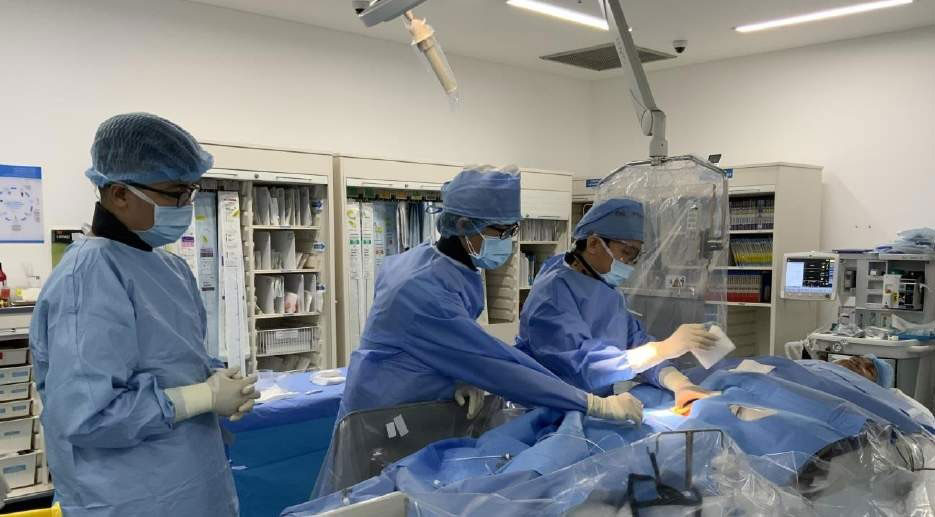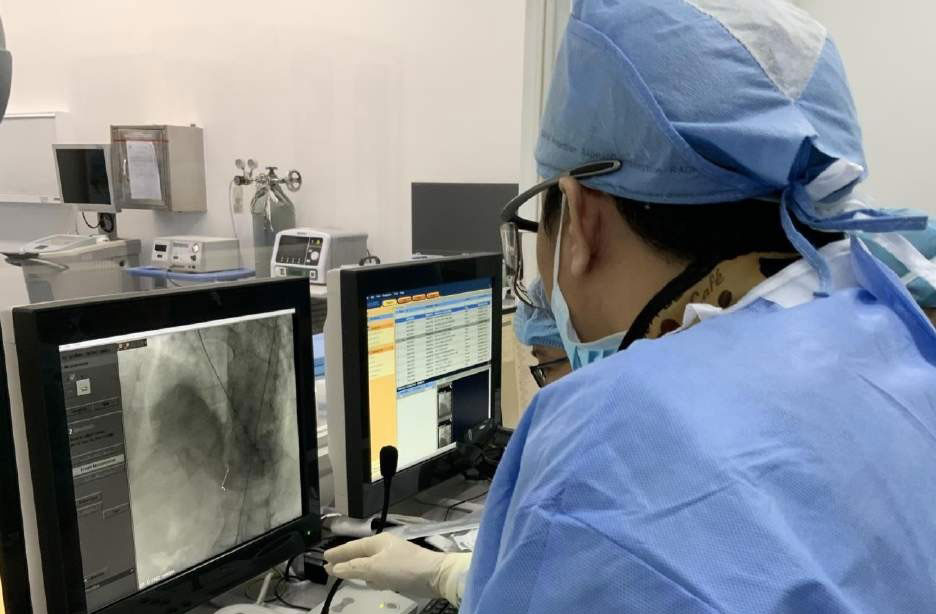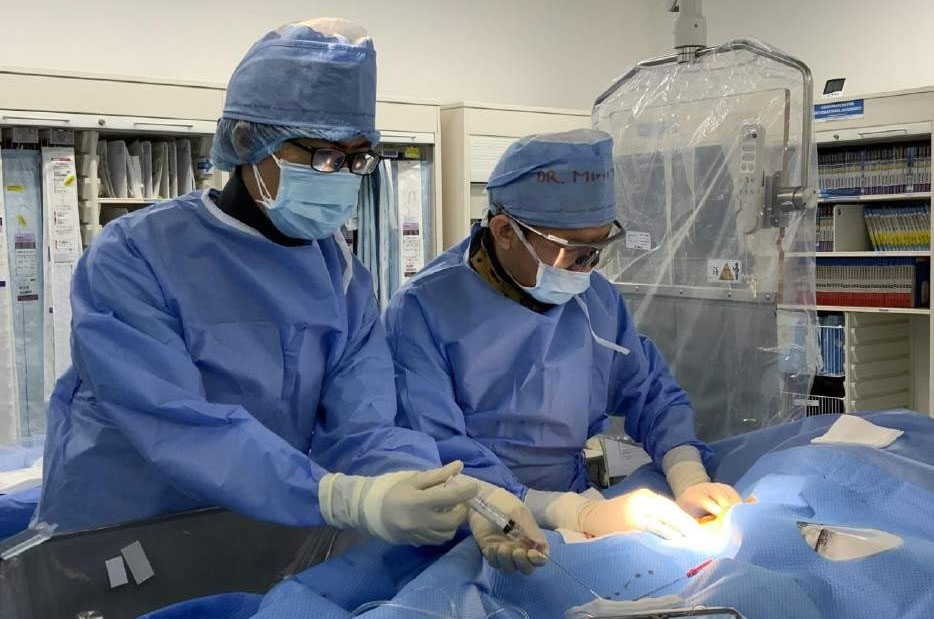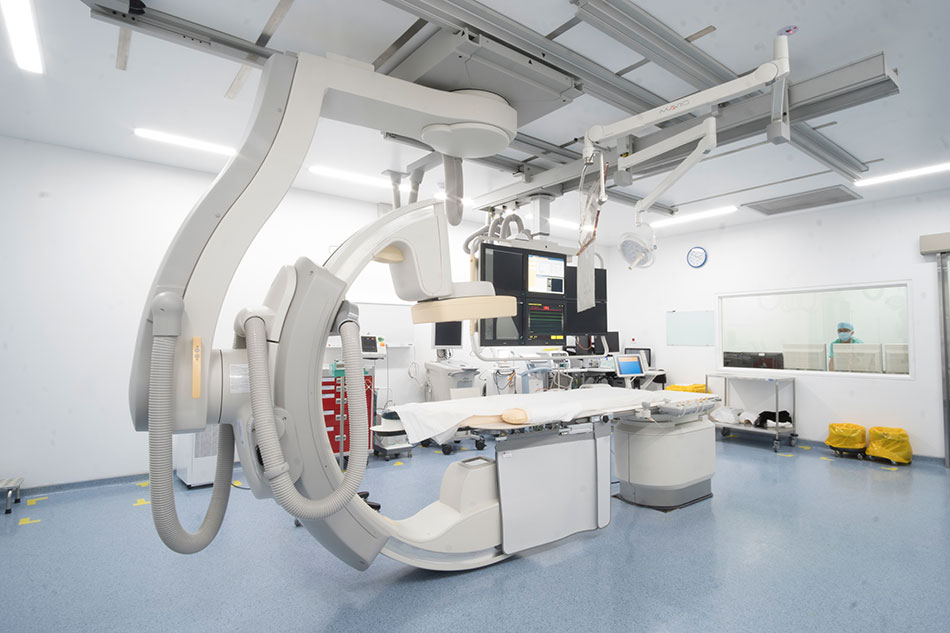Patient N.Q.T. (75 years old, residing in Binh Duong) experienced a severe myocardial infarction and coronary occlusion, resulting in heart perforation.
“FV’s doctors explained that my father’s likelihood of survival was only two per cent and they would do everything they could to save his life. While we waited as he had surgery, we were very terrified. We thought we’d never see our dad again,” recalls Mr T.’s eldest son.

Complications of severe myocardial infarction can perforate the heart
Dr Ho Minh Tuan, Head of Cardiology, FV Hospital, said that patient L.Q.T was admitted to the hospital at 1 a.m. on March 18 in an unconscious state. During clinical examination, doctors conducted an electrocardiogram and an echocardiogram, and performed related tests.
Test results showed that Mr T. was being hospitalised seven or eight days following myocardial infarction, which had caused pulmonary oedema and heart failure. Mr T.’s was a rare case with a global incidence of 0.2%, which translates to one in 500 to 700 myocardial infarction cases. The mortality rate ranges from 94-98%, with some studies reporting a mortality rate of up to 99%.
“The interventricular septum prevents blood flow between the two sides of the heart. When it is punctured, the pressure from the left ventricle is very strong and pushes blood to the right ventricle. The right ventricle pushes blood back to the lungs, causing acute pulmonary oedema and heart failure, which leads to a very high risk of death,” explains Dr Tuan.

Dr Tuan’s team places a stent to ensure blood can continue to circulate
According to the patient T’s family, he had experienced fatigue, severe chest pain, and shortness of breath an hour before entering the hospital. Mr T. was taken to the Accident & Emergency Department at FV Hospital immediately as his condition declined.
At that time, patient T.’s family began to prepare themselves for the worst.
FV doctors always implement all possible treatments to save a patient’s life
Because Mr T. was elderly and had severe pulmonary oedema and a perforated heart, as well as many underlying diseases such as diabetes and high blood pressure, the risk of performing cardiovascular intervention was very high. Despite the fact that Mr T. had a two per cent chance of survival, FV Hospital’s medical team immediately devised a treatment plan to try to save his life.
Dr Ho Minh Tuan says that the first step was to address Mr T.’s heart attack. The team placed a stent to circulate his blood and help the heart muscle begin to function again. This process was successful very quickly, within seven minutes; the longer heart muscle is left without oxygen, the faster it dies.
During a heart attack, a blood vessel in the heart becomes blocked, so doctors use small catheters threaded via a blood vessel in the arm through the peripheral artery. After identifying the lesion, they prop the narrowed blood vessel section open with stents to ensure the blood can continue to circulate to the heart’s various blood vessels. This is a difficult technique, requiring skilled, experienced doctors and modern supporting equipment.
“Open surgery was required to close holes in the heart in the past, but in recent years an interventional catheterisation can be performed to repair the hole via catheters placed in arteries and veins. The doctor measures the size of the hole in the heart and use tools shaped like an umbrella; once accurately placed in the heart, it will be opened to close the hole,” explains Dr Tuan.

Dr Tuan and his team patch the patient’s heart perforation
After one hour, doctors had successfully repaired Mr T.’s heart perforation and his vitals had stabilised.
Dr Tuan explains that it’s more difficult to patch a hole in patients with complicated myocardial infarction compared with cases of congenital heart perforation. In congenital cases, the perforation is stable and has a clear shape; for patients with myocardial infarction, due to myocardial ischaemia, the margin is uncertain and the shape of the hole is not clearly defined, making it difficult to mend. Cases like this can only be treated successfully by a team of experienced doctors working with advanced equipment.
Twelve days after his heart perforation had been closed and blood circulation restored, Mr T.’s condition was stable. Currently, Mr T.’s no longer has difficulty breathing while sleeping and can eat, drink and walk normally. His myocardial contractility is good and after it had increased from 30% to 50%, Mr T. was safely discharged on March 4, 2023.
“After the surgery, my health has improved a great deal. I have no more pain or difficulty breathing. I received a lot of attention and encouragement from the doctors and nurses as I received care here. I feel lucky that my life has been saved by the hospital. I was in so much pain before that I thought there was no way I could survive,” says Mr T.

Mr T. was recovered after two weeks of treatment at FV Hospital
A patient’s risk of death is much higher if they arrive at the hospital 10 minutes too late
When a patient has a heart attack, the blood vessels supplying the heart become blocked and the heart muscle has no blood supply, leading to the initial stages of weak or no contraction. If the patient is not brought to a hospital immediately, the myocardium is necrotic, causing death. In the case of elderly patients, their risk of death is very high if their admission to hospital is delayed by 10 to 20 minutes, Dr Tuan explains.
In addition to his advanced years, Mr T. had a medical history of diabetes, hypertension, and smoking—all factors that increase the risk of coronary stenosis which can cause cardiovascular complications and must be carefully controlled to avoid the risk of recurrence.
“For patients with risk factors for myocardial infarction, it is necessary to go to a specialist hospital for examination as soon as symptoms appear to avoid mechanical complications such as heart perforation, which can be fatal. Symptoms to watch out for include chest tightness, shortness of breath, fainting and dizziness,” says Dr Tuan.

FV’s Multifunctional Cathlab treats cardiovascular diseases
FV Hospital has invested in a modern Cathlab which is applied in multidisciplinary treatment protocols so that doctors can quickly intervene in complex and rare cardiovascular emergencies.
According to international regulations, treatment must be completed within 90 minutes of a patient with coronary heart disease and myocardial infarction being admitted to the emergency room. At FV Hospital, thanks to the well-developed and carefully implemented cardiac emergency procedure, the patient’s time from being present at the emergency room to entering the Cathlab is just over 10 minutes, and a stent can be placed in fewer than 25 minutes. By taking advantage of every golden moment in emergency, FV Hospital has performed rare cardiovascular emergencies and saved the lives of many patients with cardiac arrest and pulmonary oedema.
To be examined for cardiovascular diseases, please contact FV’s Cardiology Department: (028) 54 11 33 33.



